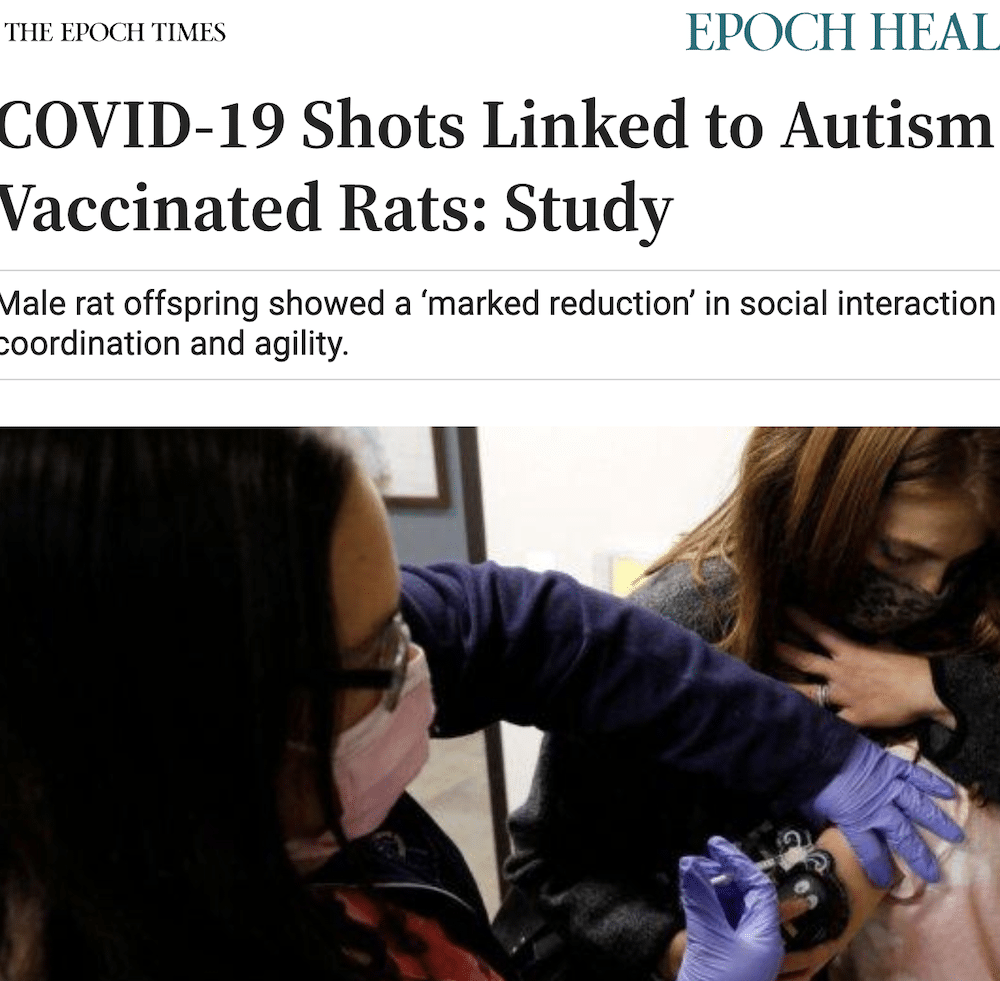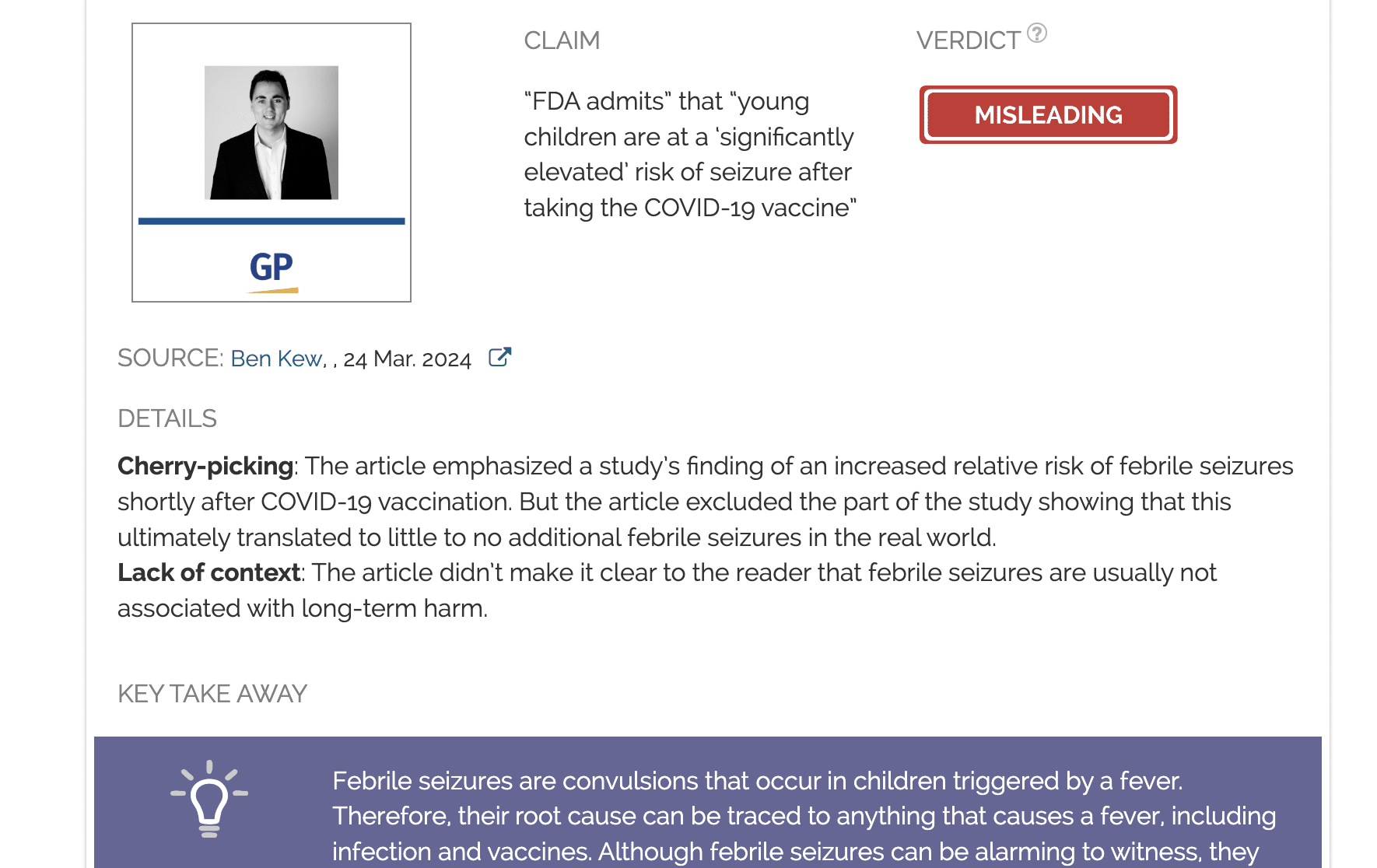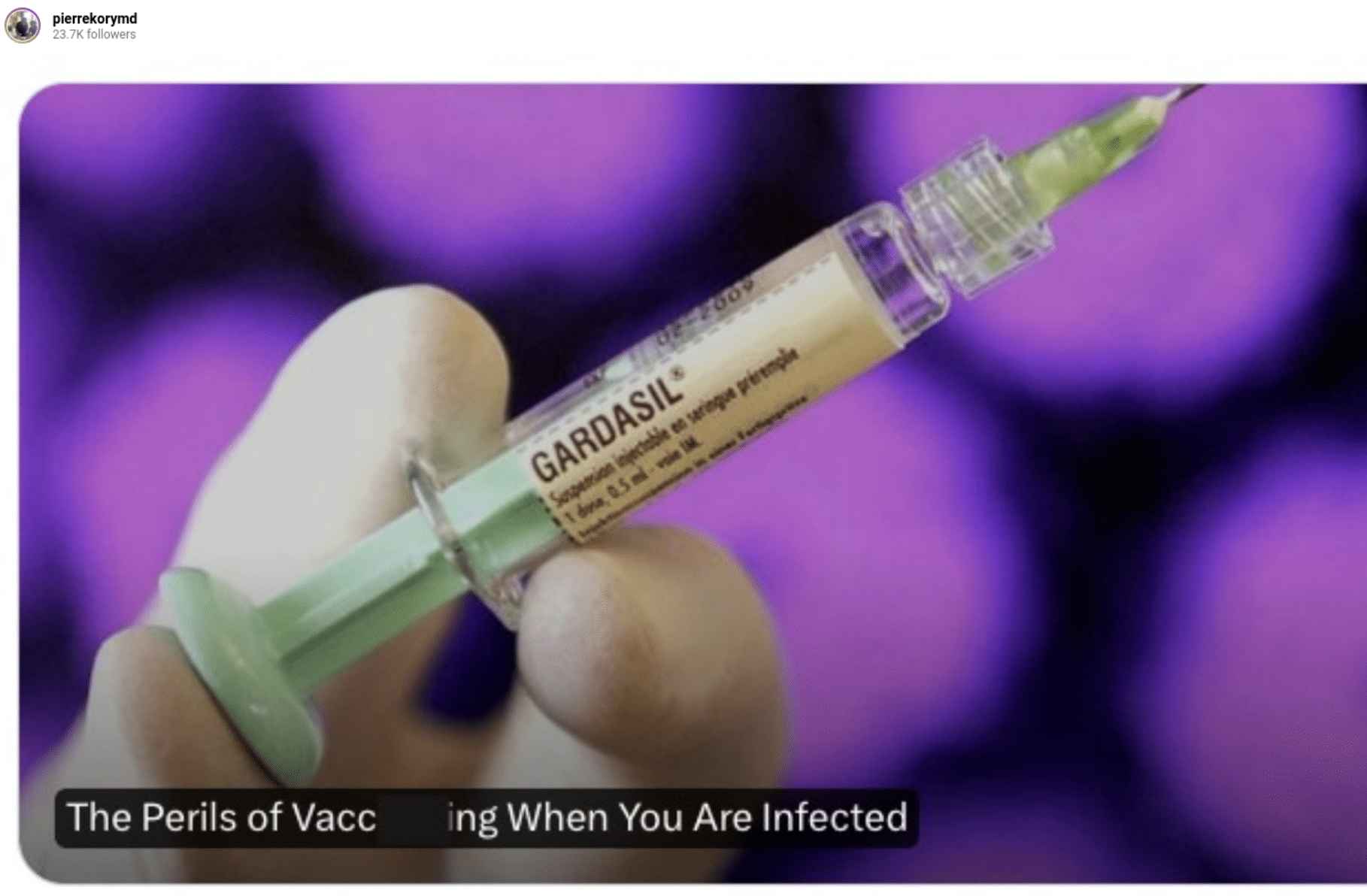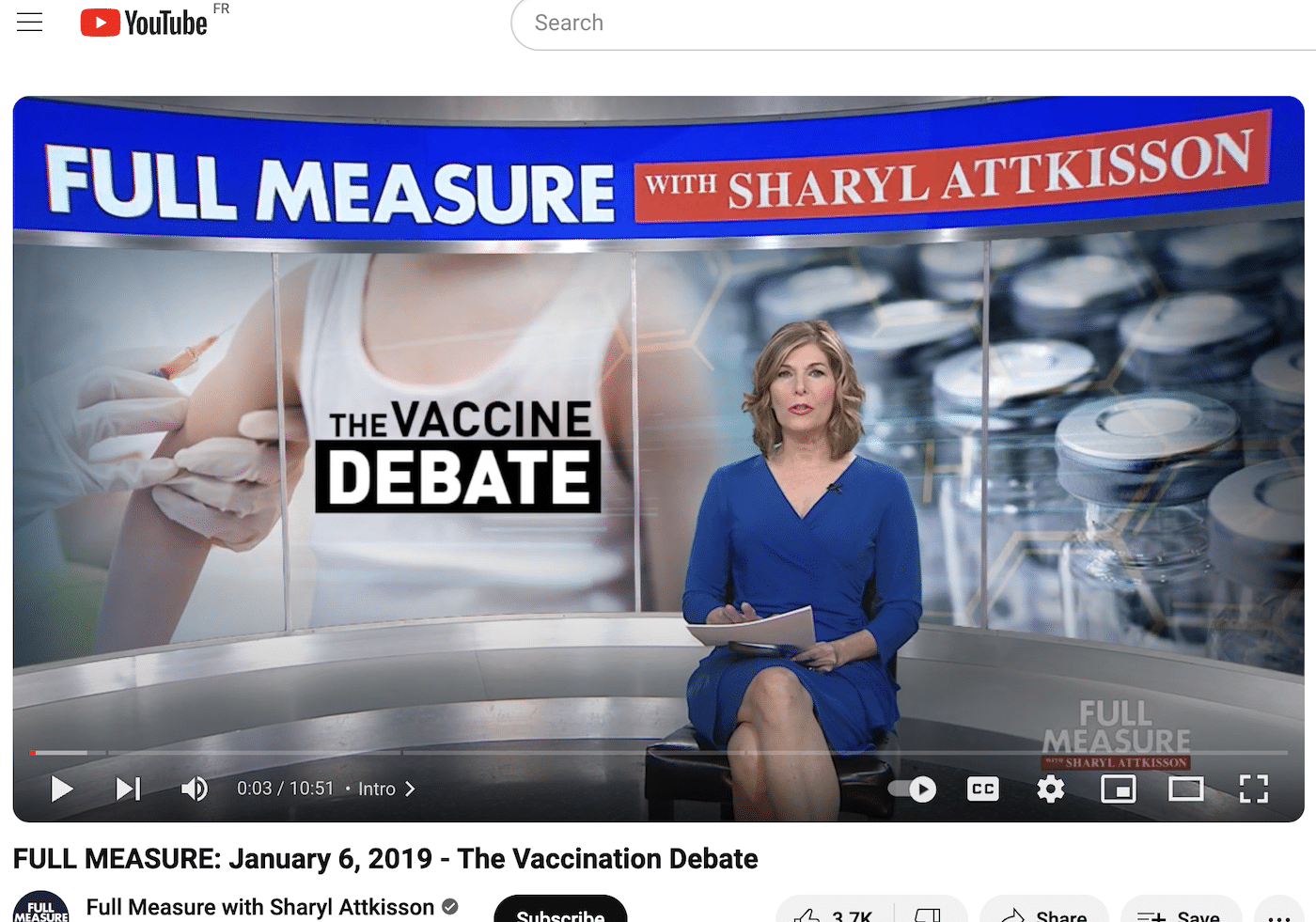- Health
Rat study alleged to link COVID-19 vaccines to autism cannot be generalized to humans and contains important limitations
Key takeaway
Autism spectrum disorder is a complex neurodevelopmental disorder that commonly manifests as difficulties with social interaction and communication, among other symptoms. Symptoms vary widely in severity. Its exact cause is unknown, although research so far has found that there are a combination of genetic and environmental factors that are related to the risk of autism. More than a dozen studies have found no association between vaccines and autism.
Reviewed content

Verdict:
Claim:
“COVID-19 Shots Linked to Autism in Vaccinated Rats: Study”
Verdict detail
Inadequate support: The experimental conditions in the study don’t represent what occurs during COVID-19 vaccination. Firstly, the study was conducted only in rats and cannot be generalized to humans. Secondly, pregnant female rats in the study received a vaccine dose that is the equivalent of a human receiving hundreds of vaccine doses in one sitting, which raises questions about its clinical relevance.
Full Claim
“COVID-19 Shots Linked to Autism in Vaccinated Rats: Study”; “COVID Vaccines Cause Autism in Lab Rats, Study Finds”
Review
A study published in the journal Neurochemical Research on 10 January 2024 became the subject of numerous social media posts on Instagram and X (formerly Twitter). These posts alleged that the study showed COVID-19 mRNA vaccines could produce autism in male rats born to vaccinated mothers.
For instance, The Epoch Times, which has published misinformation about the COVID-19 vaccines on multiple occasions, claimed that the study showed “COVID-19 Shots Linked to Autism in Vaccinated Rats”. A Substack post’s headline proclaimed “COVID Vaccines Cause Autism in Lab Rats, Study Finds”. And Instagram posts also drew on the study as evidence to cast doubt over the COVID-19 vaccines’ safety in people, receiving more than 2,000 likes in total.
Autism spectrum disorder is a complex neurodevelopmental disorder that commonly manifests as difficulties with social interaction and communication, among other symptoms. Symptoms vary widely in severity from individual to individual. Its exact cause is unknown, although research so far has found various genetic and environmental factors associated with the risk of autism, such as advanced parental age at the time of conception and prenatal exposure to air pollution and certain pesticides.
What is known is that vaccines aren’t associated with autism. More than a dozen published studies have found no association between the two, as previous Health Feedback articles reported. Nevertheless, the false claim that vaccines cause autism remains alive and well, and continues to resonate among supporters of the anti-vaccine movement, as the posts about the Neurochemical Research study demonstrate.
However, a closer look at the study shows that it contains important limitations and isn’t equipped to establish whether COVID-19 vaccination increases the risk of autism in people. The authors of the study also dispute interpretations of their study that imply the COVID-19 vaccines cause autism in humans. We explain below.
What did the study do?
Briefly, the authors hypothesized that the spike protein, either during infection or after COVID-19 vaccination, could result in inflammation that affected neural development, particularly in the developing fetus, and that might increase the risk of autism.
To explore this hypothesis in the context of vaccination, they divided 15 female rats into two groups: one that would receive saline and another that would receive the Pfizer-BioNTech COVID-19 mRNA vaccine.
After mating, the female rats in both groups received an intramuscular injection of either saline or vaccine on the 13th day of gestation. After the rats gave birth, the number of pups was culled to four. The authors explained that culling wasn’t influenced by the sex of the offspring, but apart from this there was no other information about how pups were selected for culling.
After culling, there were forty-one pups: in the saline group there were ten male and ten female rats; in the vaccine group, there were thirteen male and eight female rats.
21 days after birth, the pups were weaned by housing them separately from their mothers. Pups of the same sex and the same treatment group were housed together.
50 days after birth, the researchers assessed the rats’ behavior using several tests to measure the rats’ sociability, interest in novelty, and motor coordination.
After these tests were completed, the rats were euthanized and their brains extracted to examine the tissue under the microscope and to study the levels of certain cytokines, like interleukin 17 (IL-17) and brain-derived neurotrophic factor (BDNF), which the authors report are linked to neuroinflammation. Cytokines are small chemical molecules that cells use to communicate with each other. They are involved in numerous processes, such as immunity and development.
In the biochemical tests measuring cytokine levels, no difference was found between the saline group and the vaccine group, with the sole exception of BDNF. The researchers found both male and female rats in the vaccine group had significantly lower BDNF levels compared to rats in the saline group.
The results of the behavioral tests indicated that male rats exposed to the COVID-19 mRNA vaccine during gestation showed less inclination to socialize and less interest in novelty, paralleling certain behaviors associated with autism. There was no behavioral difference observed in female rats, regardless of treatment.
Male rats in the vaccine group also had a smaller number of cells in certain regions of the brain compared to male rats in the saline group. No difference was observed in female rats regardless of treatment.
Based on their results, the authors concluded that the COVID-19 mRNA vaccine could produce “autism-like” behavior in male rats, but also warned that their results relied on animal models, so “[c]aution should be exercised in generalizing these results to humans”.
Study used vaccine dose equivalent to a human receiving hundred of doses in one sitting
Health Feedback reached out to the corresponding author of the study, Mumin Alper Erdogan, an associate professor at the Izmir Katip Celebi University.
In an email, Erdogan clarified that he and his team “are not presenting a clinical evaluation” based on the findings of the study and that they have “no intention, desire, or effort on our part to oppose vaccinations or make similar accusations”.
He added that he himself had been vaccinated against COVID-19 and that “[w]e do not deem it appropriate for this study to be used in any news platform to support personal opinions or accusations”.
The claim that the study implies COVID-19 vaccines can cause autism has been criticized by other scientists.
One of the main criticisms of the study is the fact that it used 30 micrograms of vaccine per rat, which is a single dose for an adult human. Across the globe, the average adult human weighs 62 kilograms. The average weight of the rats used in the experiment was 220 grams, according to the study, which is about 280 times lower than an average adult human.
From here, it’s easy to see that the rats received a dose equivalent to a human getting hundreds of vaccine doses in one sitting, which isn’t what happens during COVID-19 vaccination. This drawback wasn’t mentioned in the study, but scientists took to X/Twitter questioning if the findings would be relevant in the context of vaccination.
Viki Male, a senior lecturer in reproductive immunology at Imperial College London, remarked on X/Twitter that the study “gives pregnant rats the equivalent of 300 doses of vaccine, and still all they see is a subtle difference in the behaviour of male pups”.
Immunologist Marc Veldhoen, who is a professor at the University of Lisbon, also pointed out the same issue with the choice of vaccine dose.
In response to this criticism, Erdogan stated that “there’s no established standard for mRNA vaccine dosages in rats due to the lack of specific dose studies” and that they had chosen the dose based on the minimum doses used in other species, such as chickens, dogs, and camels, required to generate an immune reaction. In such cases, “doses around 30 to 40 micrograms are commonly used” despite their differences in size, he said.
He defended the study, stating that “Instead of criticism, we would welcome other researchers to apply different dosages and share their results with the literature, so we can openly compare our findings”.
Another limitation of the study is the relatively small number of rats used in the experiments. Only three male rats from the saline group and four male rats from the vaccine group were used for the biochemical tests. Likewise, the qPCR test used to quantify messenger RNA coding for the tested cytokines used only three male rats from the saline group and four male rats from the vaccine group.
The small sample sizes undermine the results’ reliability, as the results will be prone to either overestimating or underestimating an effect. In order to minimize such errors, researchers must ensure that the sample sizes used in their study are sufficient for assessing the effect they want to study.
On top of this, Veldhoen commented that the study seemed to have performed the experiment only once, which compounds potential concerns over reproducibility.
Finally, there’s no indication that the study was blinded, meaning that researchers were aware of which rats were in the saline and treatment groups. This knowledge can introduce potential bias, especially if researchers expect to see an effect from a treatment. Blinding would help to reduce the risk of such bias in a study, for example, by hiding which rats received which treatment from the researchers conducting analyses.
Other issues observed in the study
The study reported using “an artificial intelligence-based behaviour analysis system and software” called Scove Systems, but we were unable to find information indicating that this system had been independently evaluated for its reliability. Health Feedback found that the URL provided in the study (http://scovesystems.com/) didn’t work and so reached out to Erdogan for additional information.
Erdogan acknowledged that Scove Systems was “an open-access, AI-based behavior analysis system” developed by him and his colleagues, but that they had also recorded behavioral scores “using the classical observation method with independent observers” to validate their system.
Since Erdogan is a co-founder of Scove Systems, we also asked him whether this could be a perceived conflict of interest that should have been declared in the study. Currently, the study states: “The authors declare that they have no conflicts of interest”.
To this, he responded that they had used software they developed for free and “without any financial ties as open-source software for this project”, and as such “there is no conflict of interest”. (Editor’s note: Conflicts of interest can in fact be financial or non-financial in nature.) Nevertheless, he explained that “We have communicated to the journal that we will add this clarification to the conflict of interest section as a correction and it will be revised accordingly in the process”.
Conclusion
Overall, while the Neurochemical Research study’s results can provide grounds for further exploratory studies using more animals, the study contains significant limitations that don’t allow one to reliably draw general conclusions about the vaccine’s effect in rat development, let alone its effect in human development. The authors also cautioned that their results couldn’t be generalized to humans as the study only examined animals.
Numerous scientific studies so far have found no association between autism and vaccination. Social media posts implying that the study shows COVID-19 vaccines cause autism fail to account for its limitations, such as the fact that it evaluated only animals and used a dose of questionable clinical relevance.



